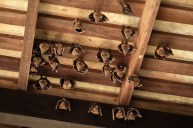Invasive insects have become a real summer pest and already invaded 17 states across the country. It's enough for officials to warn locals about the nuisance.
Spotted lanternflies are making themselves at home in the U.S. They've been spotted in 17 states in 2025 so far. World Population Review tracker says those states are Arizona, Connecticut, Delaware, Indiana, Iowa, Kansas, Maryland, Massachusetts, Michigan, New Jersey, New York, North Carolina, Ohio, Pennsylvania, Rhode Island, Virginia and West Virginia.
Pennsylvania Agriculture Secretary Russell Redding urges residents to look for and destroy the invasive insects' eggs before they have time to hatch.
"You can help keep lanternflies from becoming a summer nuisance and harming our valuable grape and nursery industries," Redding said in a April 2025 press release. "Every spotted lanternfly egg mass you scrape and squash is 30-50 damage-causing insects that won't hatch in May," he continued.
Invasive Insects
The official also urged they are intent on battling the invasive species.
"The Shapiro Administration is committed to protecting and preserving the tremendous value agriculture brings to our economy and our daily lives," Redding continued. "Funding research to develop safe, innovative pest control methods, monitoring and treating destructive pests like lanternflies aggressively, and fostering strategic partnerships between government and industry are all critical tools Pennsylvania has invested in to continue to control this destructive pest."
You can find eggs located on a variety of places such as trees and even on vehicles. Smashing them is the easiest way for population control. The invasive insect lays eggs before dying off in winter.
The press release explains, "Adult insects die off over the winter after laying tiny rows of eggs, covering them with a putty-colored protective coating. The egg masses, which can be on any outdoor surface, from trees and rocks to equipment and law furniture, each contain 30-50 eggs approximately the size of a pinhead and have survived winters in sustained sub-zero temperatures. Scraping and smashing them is easy and requires no special tools."
From there, the invasive species becomes a nuisance if hatched. So it's best to stop them before they have the time to spawn.




